#lufthansa airlines
Text
Wie kann ich mit Lufthansa telefonieren?
Lufthansa ist eine weltweit führender Flug Dienstleister und serviert ihren Flug in verschiedenen Domestiken und internationalen Flugrouten. Lufthansa bietet ihren Passagieren eine Variante von Kontakt Optionen an, wenn es um den Lufthansa-Kundenservice geht, und Sie können diese Optionen nutzen, um den Lufthansa -Kundendienst zu erreichen. In diesem Artikel werden Sie über alle Gepflogenheiten von Lufthansa kontaktieren, bitte lesen Sie diese Artikel durch.
Anruf Prozess- Im Fall, wenn Sie eine Flugbuchung oder einen Sitzplatz reservieren möchten, rufen Sie Lufthansa an, durch die offizielle Kundendienst Hotline Nummer +1 806 414-3058 zu wählen. Dann verbinden Sie sofort den mit dem Auto generierten Prozess die Sie helfen werden, um Ihre Anfrage auszuwählen und Sobald Sie die Option nach Ihrer Anfrag ausgewählt haben, dann eine der Repräsentativ von Lufthansa Ihnen über den Anruf verbinden.
Per Chat- Die Chat-Unterstützung von Lufthansa ist eine Online-Kontakt Option, die Sie nutzen können, wenn Sie den Lufthansa Kundendienst per Chat erreichen möchten. Hier sind die Schritte, die Sie helfen werden, um die Chat Option zu nutzen.
www.lufthansa.com ist die offizielle Website von Lufthansa.
Besuchen Sie diese Website und öffnen Sie die “Kontakt” Tab, auf diese Weise finden Sie alle Kontakte bezüglich Information einher mit Live Chat Ikon.
Klicken Sie auf dieses Icon an und fangen Sie die chat prozess an, um die relevante Information über Ihre Anfrage zu erhalten.
Soziale Medien- Die Soziale Medien Plattformen sind auch hier, um ihnen zu helfen. Soziale Medien , in denen Sie Lufthansa verfolgen können, sind auf folgender Seite: Facebook, Instagram, Twitter und LinkedIn. Folgen Sie Lufthansa auf diese Plattformen und direktnachrichten Sie Ihnen Ihre Anfrage, indem Sie Lufthansa auf dieser Seite folgen, können Sie auch über Ihre Anfrage kennenlernen, weil Lufthansa auf dieser Seite oft neue Flugangebote postet.
E-Mail Adresse- Die Email Adresse von Lufthansa ist: [email protected] . Diese E-Mail Adresse wird Ihnen helfen, Ihre Anfrage an das Kundendienst Team von Lufthansa zu teilen und auf diese Art und Weise werden Sie die Antwort auf Ihre Anfrag innerhalb von ein paar Tagen erhalten. Nutzen Sie diesen Lufthansa-Kundenservice und erhalten Sie die beste Aufklärung Ihrer Anfrage.
KontaktFormular- Nutzen Sie die Rückmeldung und ein anderes Kontaktformular, um Ihre Anfrage mit dem Kundendienst Team zu teilen, und hier müssen Sie nur ein Formular ausfüllen und dann senden Sie dieses Formular ab. Die Formular werden Sie auf der offiziellen Website von Lufthansa finden.
Beste Zeit mit Lufthansa zu kontaktieren.
Lufthansa ist eine sehr prominente Fluggesellschaft, die weltweit Kundendienst anbietet und das ist der Grund, weshalb es nicht einfach ist, ihn zu erreichen, aber in diesem Fall machen Sie sich keine Sorgen, weil es die beste Kundendienst Zeit gibt. Die beste Kundendienst Zeit mit Lufthansa zu erreichen, sind die frühmorgendlichen Stunden. Rufen Sie den Kundendienst von Lufthansa an, um eine glatten Anruf Prozess zu erfahren.
Welche Arten von Problemen kann der Lufthansa Kundendienst losen?
Die Telefonnummer von Lufthansa Airlines ist sehr hilfreich, wenn es um die Anfrage über Reservation, Flug, Stornierung, Rückerstattung zu erhalten usw, geht. In diesem Arten von Situationen ist alles , was Sie brauchen, die Offizielle Hotline nummer von Lufthansa.
0 notes
Text
How to reschedule Lufthansa flight?
How to Change Your Lufthansa Flight
Select My Bookings.
Enter your first name, last name, and booking code.
Click on the Find Bookings button. (all refundable bookings will appear in your booking summary)
Select the booking you want to change.
Change your flight by following the prompts.
0 notes
Photo
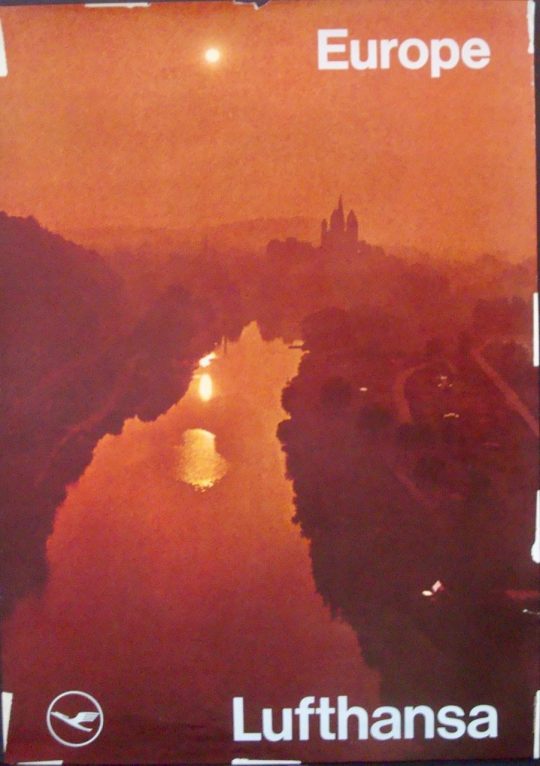
LUFTHANSA EUROPE (circa 1972) - SUNSETS ON POSTERS (Part 6/20)
A wonderful poster from Germany’s Lufthansa Airlines promoting flights to Europe with an aerial view of the Rhine river at sunset.
All our AIRLINES-TRAVEL posters are here
If you like this entry, check the other 19 parts of this week’s Blog as well as our Blog Archives
All our NEW POSTERS are here
All our ON SALE posters are here
The poster above courtesy of ILLUSTRACTION GALLERY
#illustraction gallery#illustraction#sunsets#sunset#Lufthansa#Lufthansa airlines#Lufthansa poster#Europe#rhine#1972#vintage#airlines#airlines poster#travel#travel poster
0 notes
Text


Airbus A340-600 nose arrives at any destination before the tail section ever leaves the runway
240 notes
·
View notes
Photo

Junkers G.38. Lufthansa. With Mercedes
265 notes
·
View notes
Text

"Lufthansa Heavy"
#Lufthansa#Boeing#747#Heavy jet#airliner#Jumbo jet#commercial aviation#passenger jet#plane#airplane#aviation photography
24 notes
·
View notes
Text

Munich Airport
Photo: Dieter Krehbiel
#source:forthepleasureofmylife#airport#munich#münchen#airplane#lufthansa#munich airport#airline#dieter krehbiel#green eyes 55#black and white#photographers on tumblr#black and white photography#2020s#germany#apron#source: forthepleasureofmylife#high grain#boarding#airbus a320#iphone#iphonography
26 notes
·
View notes
Text
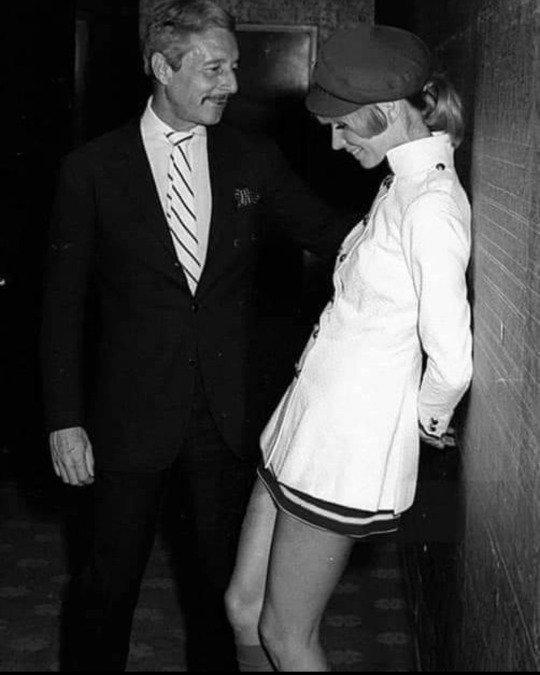
Lufthansa Airlines Fashion Show on October 20, 1967 at the Pierre Hotel in New York City. The uniform is designed by Fashion Designer Oleg Cassini💐💐
Via @isabelfutre on Instagram💐
18 notes
·
View notes
Text


35 notes
·
View notes
Text
Wie rufe ich Lufthansa Airlines über WhatsApp an?
Lufthansa Airlines bietet Ihnen verlässlichen und proaktiven Kundendienst, mit dem Sie über etliche Kontaktmöglichkeiten Verbindung aufnehmen können. Aber wenn Sie nach der Methoden suchen, rufen Sie Lufthansa Airlines über WhatsApp an, dann ist es gar nicht möglich. Derzeit hat die Fluggesellschaft diese Option noch nicht bereitgestellt und deshalb können Sie die anderen verfügbaren Kontaktoptionen verwenden, wenn Sie sich an die Fluggesellschaft wegen der Rückfrage oder Belange wenden wollen.
Wie ruft man Lufthansa Airlines per Telefon an?
Sie können den Kundendienst per Telefon anrufen und dafür verschafft die Fluggesellschaft Ihnen eine Telefonnummer. Die großen Vorteile von dieser Kontaktmöglichkeit sind, dass Sie in einer kurzen Zeit eine Antwort von einem echten Vertreter bekommen können. Also, wenn Sie den Kundendienst erreichen wollen, dann telefonieren Sie mit der Telefonnummer der Lufthansa Airlines +1 806 414-3058 / +49 (0) 69 86 799 799 und kommunizieren Sie über Ihre Rückfrage mit einem echten Vertreter.
Wie erreiche man Lufthansa Airlines per E-Mail?
Lufthansa bietet Ihnen Hilfe auch über E-Mail und dafür ist der Kundenservice über die E-Mail-Adresse [email protected] erreichbar. Durch die Nutzung dieser E-Mail-Adresse können Sie den Kundenservice per E-Mail erreichen und eine Antwort innerhalb von 24 Arbeitsstunden erhalten.
Wie nimmt man Kontakt mit Lufthansa Airlines über Live-Chat?
Wenn Sie ein kleines Problem oder Angelegenheit mit der Fluggesellschaft teilen wollen, dann können Sie sie am besten über Live-Chat kontaktieren.
Gehen Sie auf der Webseite von Lufthansa und selektieren Sie die „Hilfe und Kontakt“ Option.
Dann suchen Sie Ihren Grund zur Kontaktaufnahme aus und dadurch, dass Sie auf die „Chatten mit uns“ Option klicken, können Sie mit dem Kundenservice von Lufthansa Airlines in Kontakt treten.
0 notes
Text
No. 51 - Alaska Airlines

This is one of my most requested posts. Apparently, a very significant portion of my readers fly Alaska Airlines!
That tracks. Alaska Airlines is the fifth largest airline in the US. A sort of anti-Flair, they are supposedly the least complained-about full-service carrier in the US. They are also one of five remaining US legacy carriers, along with American Airlines, Delta Air Lines, Hawaiian Airlines, and United Airlines. They operate a massive network primarily on the US West Coast, with bits branching out into nearby slices of the Americas. As one might surmise from prior knowledge of the size and population of Alaska, they're actually mostly based in Seattle.
Now, when it comes to their livery, there's one thing that stands out. At least, it stood out to me, and I'm sure at least some of you have had this thought too.

That is a human person's face on the tailfin. But who does that face belong to, and why is it on the Alaska Airlines fleet? This is precisely the sort of trivia I think anyone who knows me would expect me to be able to just rattle off, but actually...I don't know, and neither, as far as I can tell, does anyone else. Isn't that weird?
(By the way, it is indeed Alaska Airlines. I have always found that somewhat unintuitive. It's just not how you're used to hearing things phrased, right? It's Possessive Noun Airlines, Air Noun. America Airlines would sound weird. Alaska Airlines sounds weird. I am never surprised when people mistakenly say Alaskan Airlines, but it's Alaska Airlines. Just so we're all on the same page.)
Alaska's a bit of a hard place to navigate. Big empty place, lots of ice, lots of mountains, islands, trees...not very much asphalt. That's even true now, but it used to be way truer, and even back then people did still live there. And there's a lot of things those people might maybe like to have, like medical care, or food, or just the hypothetical possibility of getting somewhere without having to get the snowshoes out. In that sense, Alaska is a really perfect place for aviation to flourish.
More or less as early as physically possible, when there were planes available that weren't requisitioned for the first World War or owned by the ultra-rich, people were flying in Alaska. In a lot of ways the basic landscape hasn't changed that much. With its surplus of difficult environments and paucity of actual tarmac Alaska's harsh wilderness is an environment only suited for "bush" flying, using smaller, more rugged airplanes specialized for the environment. Some of the most popular models of bush plane are very old, not that dissimilar to what you'd see in the 50s and 60s - apparently, they just don't make them the same anymore, and as long as you don't get your de Havilland Beaver crunched horribly into the side of a mountain there's just nothing that can replace it. Alaska is full of planes on floats, planes on skis, and taildraggers on tundra tires, most of them high-wing and piston-engined. Bush pilots are a unique sort, often doing work that's neither glamorous nor lucrative (nor safe, with Alaska having two to five times the accident rate of the lower 48) but undeniably necessary.
That's not as true of Alaska Airlines. They have a modern fleet, a good safety record except for that one time, and as a category III carrier they make over a billion dollars in revenue each fiscal year, meaning their finances aren't too strained (except for that one time). Unlike the local carriers that connect remote parts of Alaska to resources and to major cities, Alaska Airlines connects Alaska to the rest of the nearby world. (Though it also does short, multi-stop milk run flights.) It's a necessary part of the ecosystem, helping to keep Alaska's beautiful but hostile terrain from getting in the way of daily life. Before they became Alaska Airlines, though, they were far more similar to what you might expect of...Alaska airlines.

Image: Roy S. Dickson
In 1932, a man with the fantastic name 'Linious McGee' started his very own airline. You could just do that back then. In 1934 it was merged into Star Air Service, another tiny airline. Star Air Service had also been founded in 1932, born from the flight-school-starting dreams of a wealthy miner with the similarly wonderful name 'Wesley Earl Dunkle'. Apparently Star had its first ever aircraft, a Fleet B-5 biplane, brought to Alaska by steamship, which I just find fairly interesting. I guess this was before you could even ferry an airplane directly to Alaska by air. They ate up a few other small airlines (and their routes), and in 1943 they won a small scuffle against another pretender to formerly rebrand themselves as Alaska Airlines. So it's been 80 years of that now!
They've gone from flying Curtiss Robins, Ford Trimotors, and Lockheed Vegas to flying basically only 737s, save a few vestigial A320 family aircraft acquired when merging with Virgin America which they plan to phase out by the end of 2024. Their livery is also on E175 regional jets operated by Horizon Air and SkyWest. The airplanes flying for them number around 300. That's incredibly large even by the standards of major airlines (not even counting the SkyWest planes that have the livery).

The Alaska Airlines livery is not breaking any molds and I need to say that upfront. This is a very straightforward pattern I've taken to calling the Lufthansa Declined, or the Lufthansa Line SAS Variation. (Because the push and pull of trend cycles in brand identity is basically comparable to chess, right? Maybe? No? Not really?) I've recently codified the concept of the Lufthansa Line, the straight line continuing where the tailfin left off to carve through the fuselage. This is a very common and very disappointing fuselage trope. The Declined, or SAS Variation, is named for an airline I specifically contrasted with Lufthansa from my very first post on this blog, SAS.
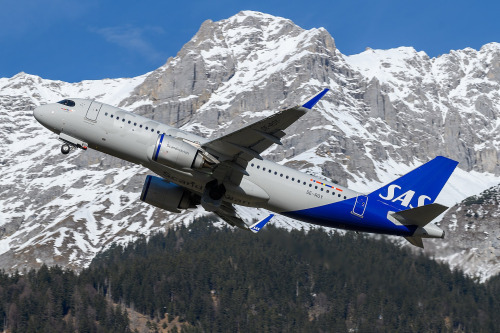
The SAS Variation simply curves this line outwards towards the front of the plane, stopping the cutoff from being quite so blunt and hopefully undoing the unbalancing effect somewhat. This can solve some of the nastier effects of Lufthansa Lines, particularly on shorter planes, but can also look very wonky if implemented without enough care. It's not always a big improvement, but it's definitely not the exact same thing, either, and it's this shape which Alaska Airlines attempts. Being introduced in 2016, this livery actually pre-dates SAS, but Delta and Lufthansa weren't starting their own namesake patterns either. The names aren't attributed based on innovation, but on formative status in my own specific understanding of airline liveries. SAS as contrasted to Lufthansa is the holotype for my creation of the taxon, and thus earlier liveries are retroactively SASlikes. Birds are dinosaurs and whales are ungulates. Taxonomy is imperfect and has to accommodate new discoveries within a sometimes unintuitive framework. That's just how it is.

I think they do better than many. The fact that they use so many colors, layered over each other, is crucial to the effect. It accomplishes similar things as a gradient might, transitioning from dark to light with minimal pain in the process.

Image taken from Alaska Airlines's very useful branding style guide.

The shades of blue and green used resemble the Aurora Borealis. I can't find anything confirming that this is intentional but I can't imagine it isn't. I think they're very nicely chosen. Different lightings can make the blue (Alaska's material calls it midnight blue, but it's technically Prussian blue) look anywhere from true vivid blue to more of a deep ocean color, which is one of my favorite shades. In particular, the very washed out yellowish green is an absolutely gorgeous choice for a highlight color. I like that the colors aren't given equal purchase, though, and that the green is used sparingly for highlight, and to create that lovely subtle 'halo' around the face on the tail. Sometimes less is more, and this is one of those cases. In fact, their own website states:
Midnight is our primary brand color, and should be used sparingly to avoid overuse—giving more prominence to the Alaska Airlines brand.
(They also note that they took specific efforts in the design process to make sure these colors had significant contrast between them to meet accessibility standards, which I really appreciate and want to see more of.)

For example, if the 'intermediate' blue colors took up more of the plane, or were separate from the green, I would probably not feel any real way about them. I definitely wouldn't think they were nice if they just did a standard Lufthansa Line block with each color individually expressed. But using them as a trim to a nice clear deep blue, overlapping each other in a way that's very carefully mapped out but seems at a glance essentially random, halfway to mixing, like the dark tail is melting slowly into the fuselage...that's nice. That adds something.

The partially-overlapping, brushlike curves are further expressed as swashes on the winglets and engines. What's interesting to me is that if you look closer you can see that the little curves are on both the inboard and outboard sides of each engine and winglet, so you get that consistent curve, hypothetically, no matter what angle you see it from. I do think I appreciate that. The curves are just never going to all line up, because airplanes are inconveniently three-dimensional and there are as many angles to view them from as there are Planck lengths at a distance where you can tell what it is you're seeing. This is a weakness in all liveries more detailed than a Braniff jellybean and adding the curves to even the side of the engine that you're usually not going to see is definitely an appreciated attempt to mitigate this. Does it work? Maybe not totally, but I see the effort.

While there's never a perfect syzygy into one continuous line, the curves seem like they're part of the same nebulous body from most angles. I appreciate this approach. I think making things look pretty good from most angles is worth more than making things look really good from one angle and awkward from all others. As they say, the perfect is the enemy of the good. I absolutely love the use on just the inside middle of the scimitar winglet, which I already think is a gorgeous feature that just elevates the MAX and retrofitted 737NGs compared to the vanilla model. It's distinctive and stylish, and the limiting of the color to just the lower half of the upper blade has a real restrained elegance to it - these slashes of color are all the more effective for the way they interact with the space around them.

Just look at these winglets. They're such a tiny feature. It's absolutely wild that I can be this in love with winglets, but there's just something about split scimitar wingtips that make me go completely wild. The amount of space and the interesting shape leaves so much more room for creativity than just about any other wingtip device. Alaska Airlines does have planes with other wingtip styles, and it uses those effectively too - covering the lower half of canted/blended winglets and fully encompassing the interior of less pronounced split winglets - but this is where they look their best.
Back to bad angles, though...


Alaska Airlines has a weird weak spot, and it's from the front and slightly above. All those gorgeous swoops on the winglets and nacelles are basically impossible to see due to their two-dimensional nature, and you can see how the colors don't fully cover the back of the fuselage. My normal policy is to judge liveries by their weakest link, but I honestly almost want to be lenient on this because of how unlikely it is that you're ever going to see an airplane from this angle. The only situations you're ever above an airplane in are ones you're basically never going to encounter as a regular passenger. Don't get me wrong, I still think this could have been designed in a way which eliminates this weak point, but as far as weak points go this is quite excusable. Is that what Thetis thought when she dipped her son in the Styx? Sure, probably, but I stand by my take. For a lot of liveries their worst angle is close to side-on, which is just fully experience-ruining. This? I'm okay with this, relatively speaking.

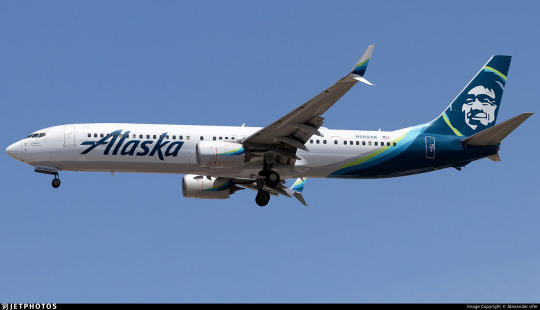
On the other hand, one of the better angles is one a lot more people will see - below and to one side. The taper of the different bands of color really prevents the awful jarring cutoff that Lufthansa Line and SAS Variation liveries often have, and I feel like they trick the eye into thinking up more of the fuselage is occupied than it really is. Also worth noting is that the grey underside, which resembles a shadow, is actually intentionally painted on, which is lovely. This is a feature common to the Deltalike livery trend that I outline at the start of my Southwest post, which I do think is one of the things that makes me honestly a bit sympathetic to Deltalikes when looking at them next to Lufthansalikes - at least there's an attempt to distribute visual detail evenly. Deltalikes were already a bit dated by 2016 (it was not the longest-lived trend, though it came at a time in my life perfectly positioned to make me think it was more prominent than it was) while SASlikes were on the rise, and this livery has aspects of each, but it feels less like a conflicted result of an intermediate period in dominant trends and more like something which intentionally pulled features from both where it thought they might work best. It's rare that I get this sense from a livery. That's the right way to use trends - as inspiration, not a template.

Alaska Airlines is definitely not a true Deltalike, and I would argue it's not a true SAS Variation either. (For the record, I would consider the 1998 SAS livery a Deltalike, funnily enough!) It incorporates features of both, which makes me feel uncomfortable classifying it definitively as either, though it's definitely more of a SASlike than not. For example, from the side it just is a SASlike, because the grey doesn't go high enough and isn't contrasting enough to be visible except from below. This is in contrast to actual Deltalikes, which have a thin but clearly visible line on the lower side where the underside's block of color bleeds out.
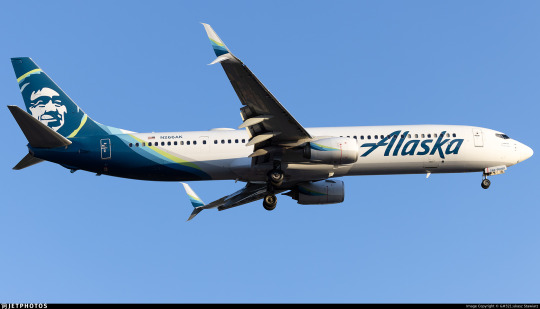

This grey color is also on the engine nacelles, although it is very subtle. This does bring up a minor gripe of mine, which is that the design on the pods cuts off at a bit of an awkwardly sharp angle, usually not worth remarking on but possible to notice from some angles if you are, say, a livery reviewer and you look at these things very closely. What I do like, though, is that the grey on the belly actively connects to the color on the tail, feeling like an extension of it instead of an awkward choice made to mitigate it.
The final specific feature of the livery I think I want to comment on is the wordmark. I really like the wordmark. It's not in their custom typeface, AS Circular, a Roboto-ish sans serif I'm not a gigantic fan of, although I really like their custom web icons. They also use Highest Praise by Adam Ladd, a fairly cheap commercially available font.

As for the wordmark itself, though, I can't seem to find what font it's based on! I have to say the original 1966 logo would be great if another airline were to use it, the 1972 is somehow giving supermarket chain, and the 1990 logo would be great if not for the weird way the K overlaps the A, which just feels sloppy and unprofessional. The 2014 and 2016 incarnations, though, are great. The 2016 one (designed by the firm Hornall Anderson) feels like a great update, just cleaning up the earlier version, though I somewhat miss the lightning-bolt S.


The placement is what I want to talk about, though. Placing a wordmark is more of an art than you might think - I'll show a couple examples of Alaska itself doing a slightly wonky job later - but when Alaska's placement is good it's great. It's one of the least cramped-looking wordmarks I've ever seen, feeling free and airy, spreading upwards above the window line. The descending line on the K and the trailing like on the A both create a feeling of freedom, like it could just keep going but doesn't want to, yet is tastefully restrained and doesn't actually overstep its bounds. I like the solid single color, and I like that it reaches almost to the engines, preventing that empty-forward-half feeling. The one thing I'll comment on for this set of images is that the left-to-right reading direction of English does mean that it looks distinctly worse seen from one side than the other. I much prefer the forward slant, which feels aerodynamic fitting with the motion of the plane, vs the alternative, in which it feels like the wordmark is trying to catch up with the aircraft's nose.
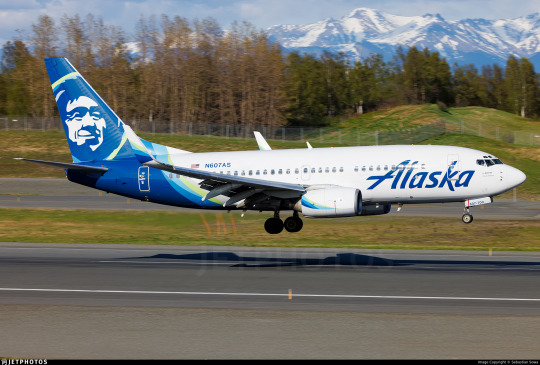
On shorter planes, though, Alaska fumbles a little. They choose to line up the wordmark with the engines instead of with the nose, creating an awkward look when it overlaps the door and nearly reaches the cockpit window. I would have leaned in the other direction were I them. This picture also demonstrates a strange feature which rears its head in certain lightings where the shading on the tailfin image makes it look almost wrinkled. I don't have anything to add to that or know how to solve it, but I need to point it out.
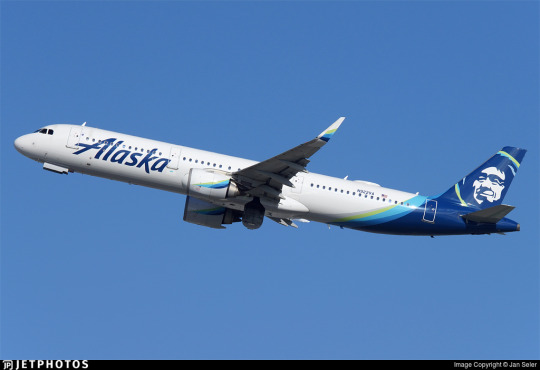
On a very long plane, conversely, the back half of Alaska's planes begins to feel that Lufthansa Line emptiness. The vast, vast majority of their planes are of a moderate enough length that neither issue is too overpowering, but I'm taking a wide view here! Also, the wordmark here seems to not be aligned with the engines, so...what's the idea?

Alaska Airlines is an interesting livery. More interesting than I thought I'd find it for sure. It's not just a SASlike with pleasing colors and a nice wordmark, it's a SASlike with thought put into features that can mitigate the inherent weaknesses of the SASlike. It doesn't always fully succeed, nor does it comprehensively fail, but it definitely tries.
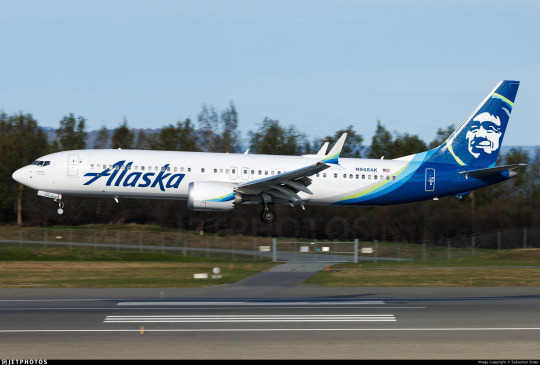
At the end of the day, as usual, I wish there was less white. I'm sure it could have been done. I don't have an obvious solution in mind like I do for some hypothetical redesigns, so it's something I would have to think over and really dig into, but, like, Alaska Airlines makes more than a billion in revenue every year so I think that's reasonable to expect from them.
I initially started using the grading system as a way to categorize liveries without limiting myself to a very specific scale that I'll dither about for years and then change my mind about later, but it's started to end up in that role. I just don't know what better solution there is, so I'm going to continue trying to make it work. Alaska Airlines is a livery that I ultimately think I like, that I think is designed decently, but that is limited by the fact that a really good SASlike is still a SASlike - mostly white and rear-heavy. It's getting the most possible out of a flawed paradigm, and I've been inconsistent so far on how I rate a good SASlike or Lufthansalike because it causes me some legitimate cognitive dissonance.
I'm giving Alaska Airlines a provisional B-.
I think I might downgrade it to C+ later, which is why I say it's provisional. A good execution of something really limited - how do I even rate that? It's somewhere between tepidly good and better-than-average, which is a really awkward place to be. But that's probably a conversation for another day, because this post is long enough and I'm still not done.
Okay, I teased this earlier.

Him. Who is he?

The short answer: nobody knows. Not me, and not Alaska Airlines.
The long answer: deserves its own post. Both because it's long, and because I've hit image limit. And there will be images. Join me in tomorrow's bonus, where we climb our way through the rugged terrain of seemingly-lost history to attempt to put a name to this ubiquitous face.

#tarmac fashion week#grade: b-#era: 2010s#era: 2020s#region: north america#region: united states#alaska airlines#legacy carriers#lufthansa declined#deltalike#skywriting
51 notes
·
View notes
Photo
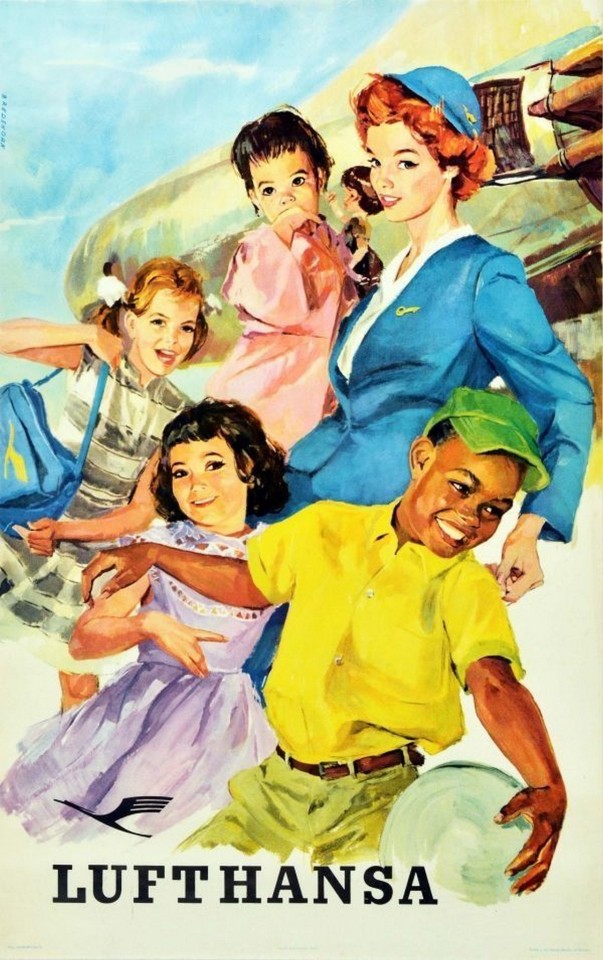
1965 Lufthansa
Source: Pinterest / Harry van Beuningen
Published at: https://propadv.com/airlines-poster-and-ad-collection/lufthansa-poster-and-ad-collection/
27 notes
·
View notes
Text

McDonnell Douglas DC-10 Lufthansa.
5 notes
·
View notes